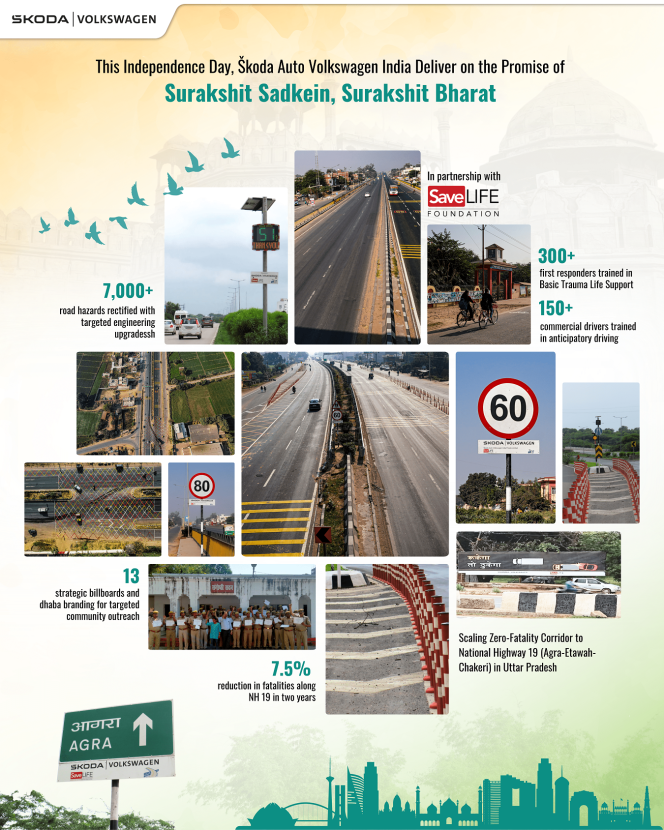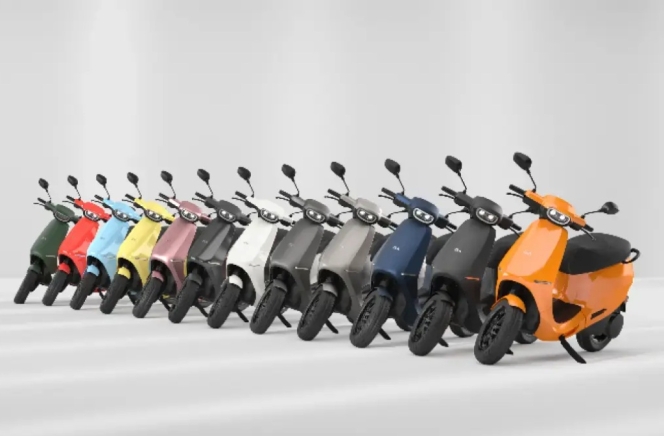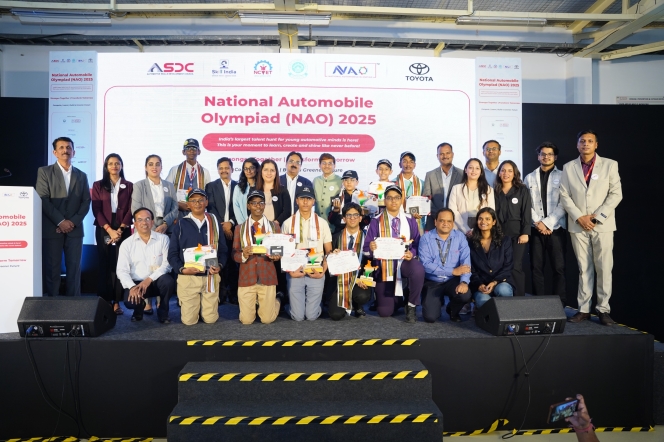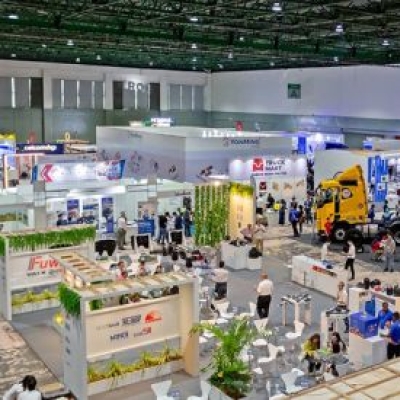Skoda Auto Volkswagen India, SaveLIFE Foundation Mark Success On NH19 Safety Initiative
- By MT Bureau
- August 14, 2025

In a joint effort to improve road safety, Skoda Auto Volkswagen India (SAVWIPL) and the SaveLIFE Foundation have successfully completed a two-year project on a high-risk section of National Highway 19 in Uttar Pradesh.
The initiative, named ‘Surakshit Sadkein, Surakshit Bharat’ (Safe Roads, Safe India), has resulted in a 7.5 percent reduction in road crash fatalities on the Agra–Etawah–Chakeri corridor since its launch in November 2022.
The program benefited over 720,000 commuters and focused on a comprehensive, evidence-based approach to road safety, addressing four key areas:
Engineering: Over 7,000 engineering hazards were fixed, with the addition of crash barriers, speed-calming measures and improved pedestrian facilities.
Enforcement: Electronic enforcement tools and new signage were deployed to improve traffic management.
Emergency Care: More than 300 first responders were trained in Basic Trauma Life Support.
Education: Awareness campaigns, including billboards and local outreach, reached a wide audience and commercial vehicle drivers received training in anticipatory driving.
This project was a collaboration with several government bodies, including the National Highways Authority of India (NHAI) and the Uttar Pradesh Police. The partners hope this successful model can be replicated in other high-risk areas across the country.
Piyush Arora, Managing Director & CEO, SAVWIPL, said, “For us, progress in the automotive sector is as much about building safer communities as it is about innovation. The Group takes safety seriously – our Made-in-India models have achieved full 5-star safety ratings, and we are committed to extending that safety beyond our cars to the roads we share. The NH 19 Zero Fatality Corridor with SaveLIFE Foundation shows that when engineering, enforcement, training, and awareness come together, lives are saved. This measurable impact strengthens our vision of a self-reliant India, where independence also means the freedom to travel without fear.”
This is the second Vision Zero Fatality Corridor project supported by SAVWIPL, following the Mumbai–Pune Highway initiative, which achieved a 61 percent reduction in fatalities.
Ola Electric Receives INR 3.66 Billion In PLI-Auto Incentive For FY2025
- By MT Bureau
- December 25, 2025

Bengaluru-based electric vehicle maker Ola Electric has received a sanction order from the Ministry of Heavy Industries for incentives totalling INR 3.66 billion. The payment is granted under the Production Linked Incentive (PLI) Scheme for Automobile and Auto Components for FY2024-25.
The incentive relates to the Determined Sales Value for the period and will be disbursed through IFCI, the financial institution appointed by the government for the scheme.
The PLI-Auto Scheme is an initiative by the Government of India designed to increase domestic manufacturing and the adoption of advanced automotive technologies. Ola Electric’s eligibility for the claim is based on its vertical integration and localisation of electric vehicle (EV) components.
“The sanction of INR 3.66 billion under the PLI-Auto Scheme is a strong endorsement of Ola Electric’s manufacturing capabilities and our commitment to building world-class EV technology in India. This incentive recognises our sustained efforts in scaling domestic production, deepening localisation, and driving innovation across the electric mobility value chain. We remain committed to supporting the Government of India’s vision of making India a global hub for advanced automotive manufacturing and clean mobility,” said the company in a statement.
bp To Sell 65% Stake In Castrol To Stonepeak For $10.1 Billion
- By MT Bureau
- December 25, 2025

UK-based energy major bp has reached an agreement to sell its 65 percent shareholding in Castrol to investment firm Stonepeak at an enterprise value of USD 10.1 billion. The deal follows a strategic review of the lubricants business and is expected to result in net proceeds for bp of approximately USD 6 billion.
The transaction includes USD 0.8 billion as a pre-payment of future dividend income on bp’s retained 35 percent stake. The valuation represents an enterprise value to EBITDA ratio of approximately 8.6x. Following the sale, a new joint venture will be formed with Stonepeak holding the majority interest and bp retaining 35 percent.
The sale is a component of bp's USD 20 billion divestment programme. To date, the company has announced or completed divestments totalling USD 11 billion.
Proceeds from the Castrol transaction will be used to reduce bp’s net debt, which stood at USD 26.1 billion at the end of the third quarter of 2025. The company aims to reach a net debt target of USD 14–18 billion by the end of 2027. bp has a two-year lock-up period on its remaining 35 percent stake, after which it has the option to sell.
Carol Howle, interim CEO, bp, said, “Today’s announcement is a very good outcome for all stakeholders. We concluded a thorough strategic review of Castrol, that generated extensive interest and resulted in the sale of a majority interest to Stonepeak. The transaction allows us to realise value for our shareholders, generating significant proceeds while continuing to benefit from Castrol’s strong growth momentum. And with this, we have now completed or announced over half of our targeted USD 20bn divestment programme, with proceeds to significantly strengthen bp’s balance sheet. The sale marks an important milestone in the ongoing delivery of our reset strategy. We are reducing complexity, focusing the downstream on our leading integrated businesses, and accelerating delivery of our plan. And we are doing so with increasing intensity – with a continued focus on growing cash flow and returns and delivering value for our shareholders.”
Anthony Borreca, Senior Managing Director, Stonepeak, said, “Lubricants are a mission-critical product, which are essential to the safe and efficient functioning of virtually every vehicle, machine, and industrial process in the world. Castrol’s 126-year heritage has created a leading market position, an iconic brand, and a portfolio of differentiated products that deliver meaningful value to its customers. We are excited to work alongside Castrol’s talented employees, coupled with bp’s continued guidance as a minority interest holder, as we support the business’s continued growth.”
The transaction is expected to complete by the end of 2026, subject to regulatory approvals. bp stated that the move allows the company to simplify its portfolio and focus its downstream operations on integrated businesses.
- Automotive Skills Development Council
- ASDC
- Central Board of Secondary Education
- CBSE
- Toyota Kirloskar Motor
- National Automobile Olympiad
- Dr Biswajeet Saha
- Vinkesh Gulati
- G Shankara
ASDC, Toyota Kirloskar Motor, CBSE Host National Automobile Olympiad 2025
- By MT Bureau
- December 24, 2025

The Automotive Skills Development Council (ASDC), in collaboration with the Central Board of Secondary Education (CBSE) and Toyota Kirloskar Motor (TKM), concluded the National Automobile Olympiad (NAO) 2025. The event took place from 17–19 December at Toyota’s manufacturing facility in Bidadi.
The initiative, aligned with the Skill India Mission, is designed to introduce school students to careers in the automotive and mobility sectors. The Olympiad saw participation from 175 students in Classes VI to XII. These participants were selected from an initial pool of over 136,000 students from schools across India and the UAE.
The three-day event included:
- Industry Masterclasses: Sessions led by experts on automotive fundamentals and emerging technologies.
- Technical Challenges: Competitions covering robotics, welding precision and technical problem-solving.
- Future Mobility Modules: Exposure to hybrid vehicles, data science and AR/VR tools.
- Industry Immersion: Visits to the Toyota manufacturing plant, the Toyota Technical Training Institute (TTTI) and test-track experiences.
The Olympiad concluded with the announcement of winners across three categories:
|
Category |
1st Place |
2nd Place |
3rd Place |
|
Grades 6–8 |
Abeer Verma (Bhopal) |
Aaradhy Pradhan (Ghaziabad) |
Dakhsh Kumawat (Indore) |
|
Grades 9–10 |
Anchit Sahai (Maharashtra) |
Arjun Annamalai (Chennai) |
Mahatva Jain (Jaipur) |
|
Grades 11–12 |
Nishanth Sudhakar (Chennai) |
Vidhan Herpalani (Dubai) |
Punith Kumar (Bengaluru) |
Dr Biswajeet Saha, Director, Training & Skill Education, CBSE, said, “We are delighted to see Toyota Kirloskar Motor hosting National Automobile Olympiad, which perfectly aligns with CBSE’s vision of experiential and skill-based learning. Events like this provide students with invaluable exposure to real-world automotive excellence and industry best practices. They also bridge the gap between classroom learning and practical application, inspiring young minds.”
Vinkesh Gulati, Chairperson, ASDC, said, “National Automobile Olympiad is a powerful platform to spark curiosity and channel young talent toward the automotive sector. ASDC is committed to building a future-ready workforce, and collaborations such as this with Toyota Kirloskar Motor provide students early exposure to real-world industry practices. The enthusiasm and technical aptitude displayed by participants reaffirm our belief in India’s next generation of mobility professionals.”
G Shankara, Executive Vice-President, Toyota Kirloskar Motor, stated, “We are proud to collaborate with ASDC in nurturing young minds through NAO 2025. By offering experiential learning and access to world-class skilling infrastructure, we aim to inspire students to innovate and contribute meaningfully to the future of mobility while supporting the Skill India vision.”
The programme concludes a cycle of assessments and training intended to bridge the gap between academic learning and industrial application in the automotive sector.
- SIAM
- Society of Indian Automobile Manufacturers
- National Road Accident Reduction Challenge 2026
- Safe Journey
- Prashant K Banerjee
- Devashish Handa
- Suzuki Motorcycle India
SIAM Launches National Road Accident Reduction Challenge 2026 For Students
- By MT Bureau
- December 23, 2025

The Society of Indian Automobile Manufacturers (SIAM) has launched the National Road Accident Reduction Challenge 2026 under its ‘Safe Journey’ initiative. The competition invites undergraduate students across India to develop solutions aimed at improving road safety and reducing fatalities.
The challenge targets undergraduate students in teams of two to four. Participants are required to submit field-tested or ready-to-implement ideas across several themes:
- User-centric interventions
- Technology-driven safety
- Infrastructure improvement
- Evaluation and enforcement
Submissions must include a 15–20 slide concept deck backed by data validation, fieldwork, or prototypes. The deadline for nominations is 15 January 2026, with final projects due by 1 March 2026.
Shortlisted teams will present their projects to a jury consisting of representatives from SIAM, vehicle manufacturers (OEMs), transport authorities and NGOs. The winning team will be awarded a cash prize of INR 250,000 at the SIAM SAFE Annual Convention 2026.
Prashant K Banerjee, Executive Director, SIAM, said, “In India, around 485 people lose their life daily due to road accidents. India’s young minds have the power to drive real change on our roads. The National Road Accident Reduction Challenge 2026 is designed to channel their creativity, problem-solving skills, and sense of responsibility into practical interventions that can be implemented on the ground. By engaging students as partners in road safety, SIAM aims to foster a culture of accountability, innovation, and safer mobility for the nation.”
Devashish Handa, Executive Officer, Suzuki Motorcycle India (SMIPL), said, “Road safety is a key focus area of Suzuki Motorcycle India’s CSR efforts. We believe that student-led innovation can contribute meaningfully to safer mobility in India. Through SIAM’s National Road Accident Reduction Challenge 2026, we aim to strengthen road safety ethics among the young generation and encourage practical, on-ground interventions to help bring down road fatalities.”






Comments (0)
ADD COMMENT